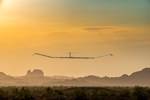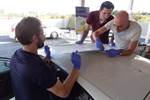Skydweller Aero conducts solar-powered carbon fiber aircraft flight
Skydweller is a large-scale autonomous aircraft made for long-duration missions.
Source | Skydweller Aero
In April, (Oklahoma City, Okla., U.S. and Alcobendas, Spain), a company developing an uncrewed solar-powered aircraft, Skydweller, completed its first successful autonomous unmanned/uncrewed flight and landing, from Stennis International Airport in Mississippi. Skydweller, manufactured from carbon fiber, has a wingspan greater than a Boeing 747 and a zero-carbon footprint.
“Our fleet of uncrewed aircraft will enable a multitude of long-duration missions that support national security and non-terrestrial communications,” says Robert Miller, CEO, Skydweller Aero. This includes continuous aerial overage above conflict zones, surveying naval activity in contested waters without risking pilots’ lives, detecting drug smugglers and pirates at sea, and tracking wildlife migration and poaching in Africa.
Skydweller aircraft are capable of perpetual flight, staying aloft for 90 days or more, at altitudes of up to 45,000 feet. In contrast, current combustion-powered aircraft, including piloted aircraft and drones, are limited to approximately 40 hours maximum flight time, limited by the endurance of pilots, the amount of fuel a conventional aircraft can carry and the need for frequent maintenance.
“We are applying 21st century materials science, artificial intelligence and software development to an industry that has spent more than 100 years building piloted, combustion-based aircraft,” Miller notes. “This allows Skydweller to leap ahead of heritage aircraft manufacturers in terms of aircraft performance, flight duration and cost effectiveness.” Moreover, solar-powered Skydwellers are said to be 10 to 100 times less expensive to operate than conventional aircraft for long-duration missions.
Related Content
-
Low-cost, efficient CFRP anisogrid lattice structures
CIRA uses patented parallel winding, dry fiber, silicone tooling and resin infusion to cut labor for lightweight, heavily loaded space applications.
-
Plant tour: Aernnova Composites, Toledo and Illescas, Spain
RTM and ATL/AFP high-rate production sites feature this composites and engineering leader’s continued push for excellence and innovation for future airframes.
-
Industrializing additive manufacturing in the defense/aerospace sector
GA-ASI demonstrates a path forward for the use of additive technologies for composite tooling, flight-qualified parts.



